Once a year, the American Museum of Natural History in New York performs a banal yet oddly fascinating ritual: It cleans its life-size model of a blue whale. It is a job almost as big as the whale itself.
Exhibition maintenance manager Trenton Dureksen spent three days in a cherrypicker, sucking dust off the 94-foot-long cetacean with an ordinary hepa filter vacuum cleaner. He started Monday, and by the time he reached the nose on Thursday, he'd emptied more than a half dozen vacuum bags of dust.
The whale has presided over the Milstein Hall of Ocean Life since 1969, its steel skeleton affixed to the ceiling and covered in fiberglass and resin. The artisans used a photo, taken in 1925, of a female blue whale discovered off the coast of South Georgia Island, to craft the creature. It got a little cosmetic surgery in 2001 to correct some anatomical inaccuracies in the fins, belly button and eyes. The leviathan weighs 21,000 pounds---impressive, but nothing compared to the 400,000 pounds real blue whales can weigh.
Duerksen had to clean every nook and cranny. Yet the job was nothing compared to the gargantuan task of cleaning the entire museum. The exhibition space spans 350,000 square feet chocked with hundreds of realistic models depicting everything from protozoa to the mighty t-rex. The museum's weirdly satisfying livestream of the whale vacuuming shows just how it fights all that dust---slowly. Veeeery slowly.

